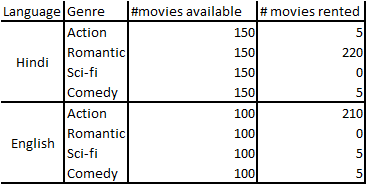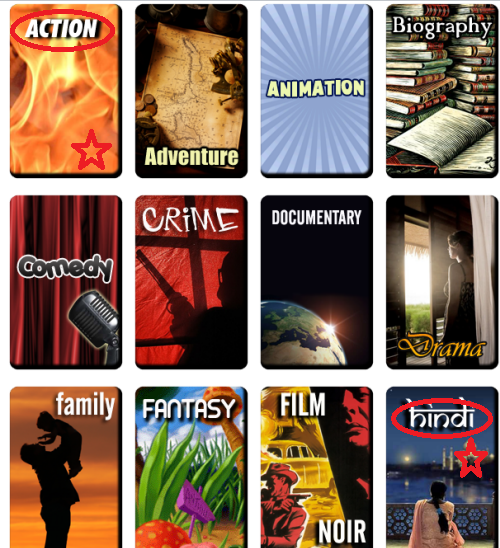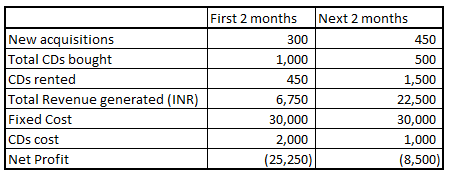Learn Analytics using a business case study : Part II
The sequel episode, of most trilogies, is often the most interesting. This is because the first episode builds a foundation, of the overall plot, and includes many mandatory but non-interesting events, but by the second episode, the director has to build sufficient interest to ensure that the viewer is hooked to the entire season. We assume that you have gone through the first part of this case study (http://bit.ly/CDcasePart1). Let’s make this article more interesting by creating a near-life simulation of the newly built business.
[stextbox id=”section”]A quick Recap : [/stextbox]
You have recently started a Video CD rental shop. After 2 months you realize that there is tough competition in the market and you need to create a more customer centric strategy to stand out. You have already built all the datasets and collected data for the first 2 months. You stand in the third month and want to maximize your profit, using data analytics.
[stextbox id=”section”] Month 3 : [/stextbox]
Here are some high level metrics indicating health of your business :
Your shop is just like all other shops and your product is no different either. Why will your customer see you differently? As of now, you have burnt around INR 32k and earned only 6.75k. This is what happens in almost all new businesses. You have no loyal customers yet; and customer acquisitions are always costly. But starting month 2, you need to stop following the old-school way of doing business.
Let’s think of all possible changes you might want to bring to your business. Following are some of them which are on top of my head :
- Customise the theme basis what customers may like
- Customise the banners basis the localities you are going to place them in.
- Identify the most popular genre and stock more CDs pertaining to the same.
- Map and profile localities which get you more business & profits. Identify more such localities for more customer acquisitions.
Now, you might have noticed that all the solutions above general in nature, and do not require any predictive modeling. This is because the business just 3 months old, and probably doesn’t have much data to build predictive models. But there is still a lot you can do to build the business further.
1. Make theme more customer-centric :
The Current Situation: As of now you have put up a banner of Hindi Comedy movies and have stacked Hindi Action movies in the front counter. Is this the right display for your target audience?
Assumption : The profile spread of your current portfolio and the future acquisition will be similar.
Idea: Imagine a new customer looking for an English Action movie looks at two competing CD shops. He will make a perception that the probability of finding a CD of his choice is more in the shop with banner of English movies.
Analysis : Our target should be, to display more genres that people will want to rent. People, who would like to rent a CD, may not really be interested in Hindi Comedy and Hindi Action movies. Since the movies available in each genre are similar, and the choice of movie genre is not restricted by availability, the two categories, which stand out are Hindi Romantic and English Action. Hence, both, the banner and the display should correspond to only these two categories.
2. Make each advertising banner focused to local taste :
The second pointer is very similar to first analysis. But here you break the audience basis the locality or area they belong to, and decide on the most popular genre in the area. This thought process should govern your marketing banners strategy.
3. Genre wise Inventory/Stock optimization :
The third pointer is derived from the same analysis, as described in point 2. Our analysis showed that people prefer Hindi Romantic and English Action movies. Now, after revising the display and banners, the client base would expect a larger variety corresponding to these two genres, even more. Hence, stocking the same number of CDs, in each genre, may not be required and wouldn’t be justified.
4. Target most profitable societies for acquisition :
The fourth pointer however needs a slightly different analysis. This pointer would need us to identify areas with the highest profitability. The tricky part is, that you would need to find out the profit at an individual customer level. In the table below, the cost incurred on a society is the cost of installing the customised banners. The revenue generated, is calculated by multiplying INR 13, with the CDs rented in total by the society. In the data below, we have assumed that the same amount of money was spent in marketing, in 5 different societies.
If we had not done this calculation, we may have assumed that targeting a high standard society, would be most profitable because the number of CDs bought by each customer was higher. But from this analysis it is clear that the conversion rate in such a society is also less. Hence, it is best to target the Medium standard society.
Note that this rank order might change with time. Given the trends, with time the number of repeat customers in high standard society might raise significantly higher, but the same cannot be concluded as of now. Hence you will want to market more and acquire more customers from medium class societies.
[stextbox id=”grey”]Here is a summary of strategies we recommend for the month 3 :
1. Change the banner and front desk of movie genre to English Action and Hindi Romantic
2. Put customized banners in different kinds of societies, according to the society’s taste
3. Stock more titles in the English Action and Hindi Romantic genre.
4. Market the business, more in Medium standard societies similar to “HEWO society”.
[/stextbox][stextbox id=”section”] Month 5 : [/stextbox]
Here are some of the high level metrics for your business :
You see a good improvement in the total sales and the net loss you make month on month. If the trend goes, you would start making a profit over the month on month, running costs in the next 1 or 2 months. This itself is an insight, and the first step towards prediction. Since you are ambitious, you would want to introduce some cutting edge marketing strategy. Here is what you can do:
- Identify most valuable customers, send movie reviews & other value added services to these customers
- Innovate, and come up with new services like home delivery, weekly packages, promotional packages etc. to targeted customers
- Create targeted marketing campaigns for each type of new product.
- Create a website to promote your shop and collect information of trailers viewed by the customers.
- Create an optimized inventory management system to make sure you are never stocked out
- Create proper retention/win-back processes
As you might have observed, all the pointers are customer level marketing tools. Now we are not talking at the portfolio level, but have drilled down to the customer level. This is because now you have about 750 customers’ data to play with. The thumb rule here is, that customer analytics should be done on a statistically significant number, which in most of the industries is taken to be at least 500. We will talk about customer level analysis in the next article and take each of the pointers one by one to find some key insights and frame strategies from the 5th month onwards.
[stextbox id=”section”] End Notes : [/stextbox]
In this part of the case study, we looked at framing initial portfolio level strategies, and how data guides us to take some key initial decisions in a new business. Next, we will look at some interesting customer level strategies which can be derived using data sources mentioned in part I of the case study.
The reason we have segregated customer level analytics from porfolio level analytics is that the two analysis are done with very different mind sets. In the portfolio level, we focused more on mass media and themes. Whereas, in the customer level, you will focus more on targeted marketing, engagement and other key strategies.
Did you find the article useful? Share with us how you would have approached making strategies mentioned in the article. Do let us know your thoughts about this article in the box below.
If you like what you just read & want to continue your analytics learning, subscribe to our emails, follow us on twitter or like our facebook page.
Next part of case study: Learn Analytics using a business case study: Part III

















Hi Kunal, well-written case. Would like to know if you have case studies that covers application of Analytics for B2B customer segmentation ESP in technology / telecom sector Thanks for your help. Rgds, Arvind Shastry
Thanks Arvind. As of now, we do not have a ready case study in these sectors. However, we have received similar requests from several people. Will keep this in mind for future and do let you know whenever we publish something of this sort. Thanks, Kunal
Hey, Good case study.I am planning to present to my team(bunch of BSAs) on "structured thinking n writing " wondering if u have any good tips for putting together the deck on that topic.I have few ideas plan to talk about like classification structure ,reasoning structure ,using structures in story creation etc Thanks, Jaya
this is very helpful and first of its kind explanation of analytics for the layman...thanks!
Fantastic approach